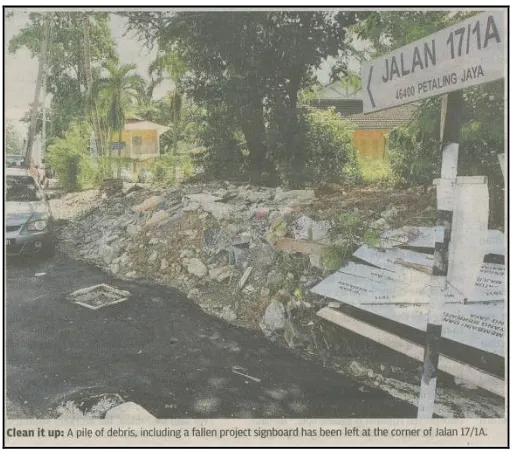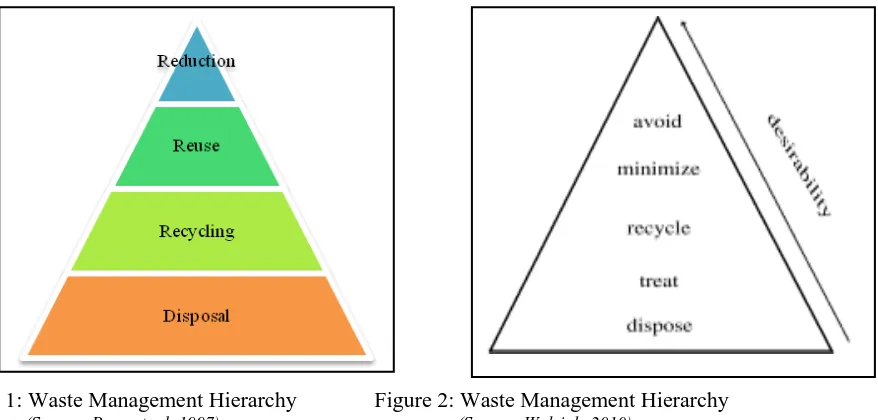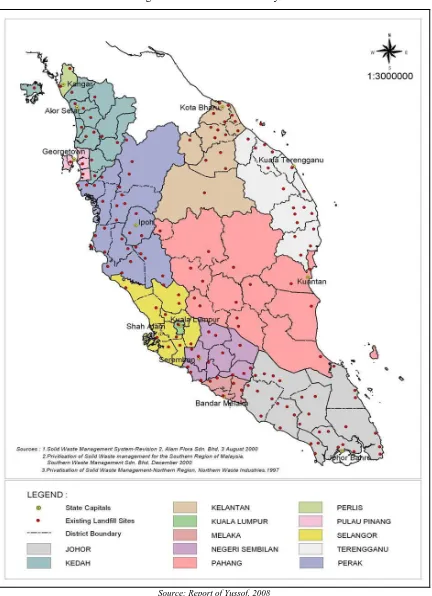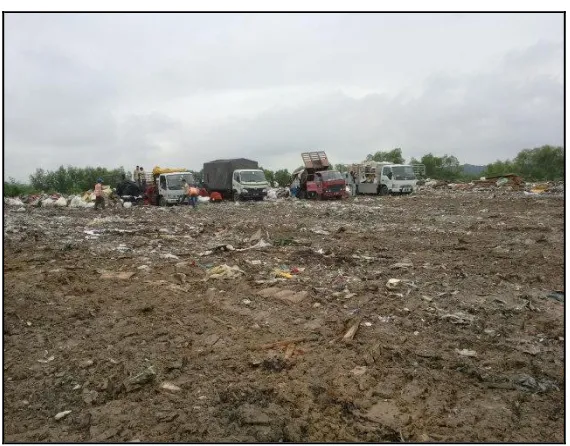Construction Waste Management: Malaysian Perspective
Sasitharan Nagapan*
1, Ismail Abdul Rahman
2, Ade Asmi
3 1,2University Tun Hussein Onn Malaysia, 86400 Parit Raja, Batu Pahat, Johor, Malaysia
3Bakrie University, Jl. H.R.Rasuna Said Kav. C-22, Jakarta 12920, Indonesia
Correspondent email: sasi81@yahoo.com
Abstract
Construction industry is considered as major stimulant to Malaysia economy. However, it also generates waste from the construction activities. Managing construction waste is also an issue if not properly handle as it will gives negative impact to environment, social and finally economy. This paper presents the issues surrounding construction waste experience in Malaysia. It discusses about illegal dumping of construction waste due to attitude of the parties involved in construction industry and also common waste management strategy in Malaysia using disposal methods into landfills. Malaysia needs to embark towards waste management hierarchy through the enactment of specific construction waste regulation.
Keyword: construction waste; Illegal dump; waste management hierarchy
1.0
Issues on Construction Waste
Construction waste generation is becoming a pressing issue in Malaysia (Begum et. al, 2007; Begum et. al., 2010). There are a lots of construction waste generated in the country because of rapid development in construction industry. Demand of houses and major infrastructure projects make the amount of construction waste getting increased (Nasaruddin et. al., 2008; Siti and Noor, 2008).
Figure 1: Construction waste illegally dumped in mangrove swamp (Source: The Star Newspaper, 2011)
Figure 2: Construction debris along roadside (Source: The Star Newspaper, 2012)
These illegal dumping has causing risk to human health and environment (Faridah et. al., 2004; Rahmat and Ibrahim, 2007). The issues of illegal dumping arise according to Seow and Mohamad, 2007 is due to the cost and project location factors. Distance between the project location and the landfill site hinder the contractor to dispose in legal landfill. The contractors intended to maximise profit by avoiding transportation cost and payment charge to the gazetted landfill.
2.0
Waste Management Hierarchy
Construction waste should not directly dispose however it needs to pass through several processes before being disposed. It should be treated according to proper waste management hierarchy as proposed by Peng et. al., 1997 in Figure 1. The waste management hierarchy suggests that waste should be reduced, reused, recycled then be disposed to proper dumpsite like landfill. Further research by Wolsink in 2010 has improvised the waste management hierarchy as in Figure 2. He introduced one step more by avoiding the waste generation.
Figure 1: Waste Management Hierarchy Figure 2: Waste Management Hierarchy (Source: Peng et. al.,1997) (Source: Wolsink, 2010)
However the terms avoid, minimize and reduction from Figure 1 and 2 are literally similar in actions. What is important is to prevent the generation of the construction waste (Osmani et. al., 2008; Peng et. al., 1997). In Hong Kong, the government focuses in reducing the waste at the source. This attempt in somehow will avoid any activities and process that can cause the waste generation (Tam et. al., 2007). Common understanding and regular emphasizing through meeting amongst all parties about the importance of avoiding the waste generation is a good approach in avoiding the waste generation (Zhao and Chua, 2003).
Since the waste generated is not fully avoidable, the next step should be consider is to reuse some of the construction waste likes using broken brick and concrete as a sub-grade of access road to the construction site. For waste that cannot be used at the site, it can be sorted for recycle purpose. Wastes like wood, steel, plastic and others can send to recycle factory. These efforts have to be carried carry out in order to reduce the disposal amount of construction waste to landfill. Thus, it will extend the life span of landfill. Following the steps in the waste management hierarchy is benefited to the environment and economy to a country (Tchobanoglous and Keith, 2002). Unfortunately, most of the contractors do not like this good practice of hierarchical waste management steps because they argued that the waste materials have little premium value and these cause them to dispose the waste in landfills (Poon et. al., 2004).
[image:3.612.101.540.201.411.2]dumpsites. However, 113 of these landfills are no longer in operation due to protest from the surrounding residents or have reached their full capacity. The balances of 176 landfills which are in operation are as in
Table 1. All the landfills are under the jurisdiction of local authority except a few owned by the Federal Government (The Ingenieur, 2009). The Malaysia Government is still planning to open another 9 more landfills to cope with the demand (Jurutera, 2011). Since landfill is simple and cheap method unlike incinerator which is more expensive and requires technological experts to operate it.
Table 1: Landfills in Malaysia
State Operational
Landfills
Non-Operational Landfills
Perlis 1 1
Kedah 11 4
Pulau Pinang 1 2
Perak 20 9
Pahang 19 13
Selangor 7 12
Federal Territory Putrajaya 0 0
Federal Territory KL 0 7
Negeri Sembilan 8 10
Melaka 2 5
Johor 13 21
Kelantan 13 4
Terengganu 9 12
Federal Territory Labuan 1 0
Sabah 20 1
Sarawak 51 12
Total 176 113
Overall Landfills 289
Source: Department of National Solid Waste Management, The Ingenieur, 2009
Figure 3: Landfills site in Malaysia
Figure 4: Manual sorting on site
[image:6.612.164.449.363.586.2]
Figure 6: Levelling activity using bulldozer
Figure 7: Stacking of recycled wood
3.0
Legal and Enforcement
[image:8.612.67.546.194.587.2]Construction waste management can be viewed from legal and enforcement perspectives. It requires proper legal system to give framework for partiers involves in construction industry. To make sure the system is in placed enforcement has to be exercised to give deterrent to parties that not abide the laws. This study identified several authorities and law under their jurisdiction in handling solid waste are as in Table 2.
Table 2: Authorities involving in construction waste management
Sources: Act 672, Act 127, Act 520 and Standard Specifications for Buildings Works
As in Table 2, the first authority is the Ministry of Housing and Local Government with its Solid Waste and Public Cleansing Management Act 2007 (Act 672). This act is to provide and to regulate the management of controlled solid waste and public cleansing for the purpose of maintaining proper sanitation under the housing and local government authority. The act has limitation where it covers housing scheme and area governs by local government jurisdiction. The regulation is more focuses on avoiding the waste from contributing to improper sanitation. Even though the act did specify construction solid waste as part of controlled solid waste but the whole scope of managing the construction waste is not enough as compared to the steps given in the waste management hierarchy.
Authorities Laws / Acts /
Standard Scope Remarks
Ministry of Housing and Local Government
Solid Waste and Public Cleansing Management Act 2007 (Act 672)
This act is to provide and regulate the management of controlled solid waste
and public cleansing for the purpose of maintaining proper
sanitation.
The solid waste is defined inclusively in the construction solid waste
Ministry of Works Standard Specifications for Buildings Works (2005 Edition) Clause 46.3
This standard is only applied to contract works awarded using
JKR procurement approach.
Clause 46.3 (clearance, cleaning and making good ) completion states it is the duties of the contractor to gather up and clear away all rubbish / garbage / construction waste as it accumulates during the progress of the Works at least twice each week at times approved by the Superintending Officer.
Ministry of Natural Resources and Environment
Environmental Quality Act 1974
(Act 127) -Part IV Section 24
(2b)
This act is to prevent, abatement, control
pollution and to enhance environment
within Malaysia
Part IV Section 24 (2b) (prohibition and control of pollution) states a person deem as pollute soil or land if disposal solid waste can be obnoxious and offensive to human beings; effects underground water; detrimental soil and surface of land.
Construction Industry Development Board Pembinaan Malaysia Act 1994 (Act 520) -
Part IX Section 35 (2)
This act is to provide functions relating to
the construction works
The second is the Ministry of Works through the Standard Specifications for Buildings Works (2005 Edition). The standard is solely for contractors who are handling project with Public Work Department (JKR). The standard is applied to contract works awarded using JKR procurement approach. The construction waste handling appears in the standard under the Clearing, Cleaning, and Making Good on Completion Clause. It briefly explains that the clearing garbage or construction waste has to be done twice a week. It did mention that contractors are needed to dispose the construction waste in landfills or approved sites.
The following authority is Ministry of Natural Resources and Environment with its Environmental Quality Act 1974 (Act 127). The act scopes are to prevent, to reduce, to control pollution and to enhance environment. The wastes appears in this act are more related with general environmental problems. The wastes are interpreted as liquid, solid, gasses and radioactive. The wastes are either normal waste or schedule waste (Mustafa, 2011; Environmental Quality Report, 2006). The drawback of the law is it considers waste when it is deposited and cause pollution to environment.
The final authority that concern waste is the Construction Industry Development Board (CIDB) and the law under it supervision is Pembinaan Malaysia Act 1994 (Act 520). There are 10 parts prescribes under this act namely Preliminary; The Lembaga; Chairman, officer and servants; Finance; Other power or The Lembaga; Registration of Contactors; Accreditation and Certification; Levy; Enforcement and investigation and General Part. In this act, only Part I and Part IX can be related with construction waste issues. Part 1 describes construction works whilst Part IX is more towards enforcement and investigation. The act is to provide functions relating to the construction works in the country. It gives power to investigation officer for entering construction site at any times to do inspection. This enforcement law gives the authority to act upon construction waste left on site through the term of site clearance. However it does not fulfil the spirit of waste management hierarchy.
In order for Malaysia to move toward green or sustainable environment, the country has to benchmark developed nation like Japan and Hong Kong in handling construction waste issues. Japan manages their construction waste in sustainable manner where in 1991 the Japanese Government has established Recycling Law. The law empowers minister to select materials for recycle and encourage reuse of those materials in the country (Kawano, 2003 cited in Rao et. al., 2007). Several positive steps taken by Japanese Government, such as compulsory requirement of Waste Management Report for public or private construction projects; Waste management clauses of contract for contactors; Submission of Sorting Report and obligation to sort on site under Construction Recycle Act and establishment of Standard for Recycle Construction Waste (Gao and Ming, 2008). These legal approaches taken by Japanese government made the country become more sustainable in handling construction waste.
Hong Kong is another country that has able to manage construction waste very well. Hong Kong Government has introduced Construction Waste Disposal Charging Scheme (CWDCS) in December 2005. The scheme is to ensure the disposal of construction waste properly. A survey conducted revealed that waste dumped to landfills has reduced by approximately 65% after the implementation of CWDCS. Thus, this indicates the implementation of the CWDCS has effectively reduced construction waste disposal and helps to improve the country environment (Hao et. al., 2008).
4.0 Conclusion
References
[1] Act 127, Environmental Quality Act (1974), Ministry of Natural Resources and Environment, 1-17.
[2] Act 520, Pembinaan Malaysia Act (1994), Construction Industry Development Board, 1-16.
[3] Act 672, Solid Waste and Public Cleansing Management Act (2007), Ministry of Housing and Local Government, 1-7.
[4]Begum, R. A., Satari, S. K. and Pereira, J. J., (2010). Waste Generation and Recycling: Comparison of Conventional and Industrialized Building Systems. American Journal of Environmental Sciences, 6(4), 383-388.
[5]Begum, R. A., Siwar, C., Pereira, J. J., and Jaafar, A.H., (2007). Factors and values of willingness to pay for improved construction waste management-A perspective of Malaysian contractors. Journal of Waste Management, 27, 1902-1909.
[6]Environmental Quality Report (2006), Kuala Lumpur: Jabatan Alam Sekitar, 2007, 64.
[7]Faridah, A., H., A., Hasmanie, A., H., Hasnain, M., I., (2004), A study on construction and demolition waste from buildings in Seberang Perai, Proceeding of 3rd National Conference in Civil Engineering, Copthorne Orchid, Tanjung Bungah, Malaysia.
[8]Gao and Ming Z.A., (2000), Construction and Demolition Waste Management: From Japan to Hong Kong. Griffin's View on International and Comparative Law. Available at SSRN: http://ssrn.com/abstract=1131984, retrieved on 13 February 2012 at 11.15 a.m.
[9]Hao J. L., Hills M. J. and Tam V. W. Y., (2008). The effectiveness of Hong Kong's Construction Waste Disposal Charging Scheme, Journal of Waste Management and Research, 26(6), 553-558.
[10]Jurutera, (2011). Reduce, reuse and recycle, The Institution of Engineers Malaysia (IEM),8, 6-9.
[11]Lau, H.H, Whyte, A. Law, P.L. (2008). Composition and Characteristic of Construction Waste
Generated By Residential Housing Project. International journal of Environmental Research, 2(3), 261-268.
[12]Mustafa, M. (2011).Environmental law in Malaysia. Kluwer Law International BV, The Natherlands, 98-99.
[13]Nasaruddin, F.H., Ramli, N.H.M., and Ravana, S.D (2008), E-Construction Waste Exchange in Malaysia: A Preliminary Study, Proceedings of Information Technology International Symposium 2008, Kuala Lumpur, Malaysia.
[14]Osmani, M., Glass J., and Price, A.D.F. (2008). Architects perspectives on construction waste reduction by design. Journal of Waste Management, (28), 1147–1158.
[15]Othman, F.H. (1993). Material and waste flows on Solid and Hazardous Wastes Management. Universiti Teknologi Malaysia, Johor Bharu.
[16]Peng, C.L.; Scorpio, D.E.; Kitbert, C.J. (1997). Strategies for Successful Construction and Demolition Waste Recycling Operations. Journal of construction Management and Economic, 15(1), 49-58.
[17]Poon C. S., Yu A. T. W., Wong S. W., and Cheung E. (2004). Management of construction waste in public housing projects in Hong Kong. Journal of Construction Management and Economics, 22, 675-689.
[18]Rahmat, N. S and Ibrahim, A. H. (2007), Illegal Dumping Site: Case Study in the District of Johor Bahru Tengah, Penang, Malaysia.
[20]Seow, T. W and Mohamad, A. H (2007). Construction Waste Management on Site. Proceedings of Universiti Perguruan Sultan Idris, Tanjong Malim, Perak.
[21]Siti, N. M., and Noor, Z. M. (2008), Approach in construction industry: A study on prefabrication method as a tool for waste minimization, Proceeding of International Conference on Environmental Research and Technology (ICERT), Penang, Malaysia.
[22]Standard Specifications for Buildings Works (2005 Edition), Ministry of Works, 1-15.
[23] Tam, V.W.Y., Shen, L.Y., Fung, I.W.H., and Wang, J.Y. (2007). Controlling construction waste by implementing governmental ordinances in Hong Kong. Journal of Construction Innovation, 7(2), 149-166.
[24] Tchobanoglous, G. and Keith, F. (2002). Handbook of Solid Waste Management (2nd Ed.), McGraw-Hill.
[25]The Star, Murali, R.S.N. (2011, September 22). An Irresponsible Act: Tropical Mangrove Swamp has Become a Construction Dumpsite. Page 3.
[26]The Star, Tan, K.W. (2012, January 10). MBPJ to clear debris before Chinese New Year. Page 4.
[27]The Ingenieur, (2009). Sanitary Landfill: A Strategic Approach Towards Solid Waste Management, Boards of Engineers Malaysia (BEM), 42, 12-16.
[28]Wolsink, M. (2010). Contested environmental policy infrastructure: Socio-political acceptances of renewable energy, water and waste facilities. Journal of Conflict Mediation and Social Impact Assessment, 30 (5), 302-311.
[29] Yahaya, N. and Larsen, I., (2008), Federalising Solid Waste Management in Peninsular Malaysia, Proceeding of International Solid Waste Association (ISWA) World Congress, Singapore.
[30] Yussof, H. H. M. (2008). Report on Solid Waste Management Rules, Solid Waste Management and Public Cleansing (PPSPPA), Ministry of Housing and Local Government.






